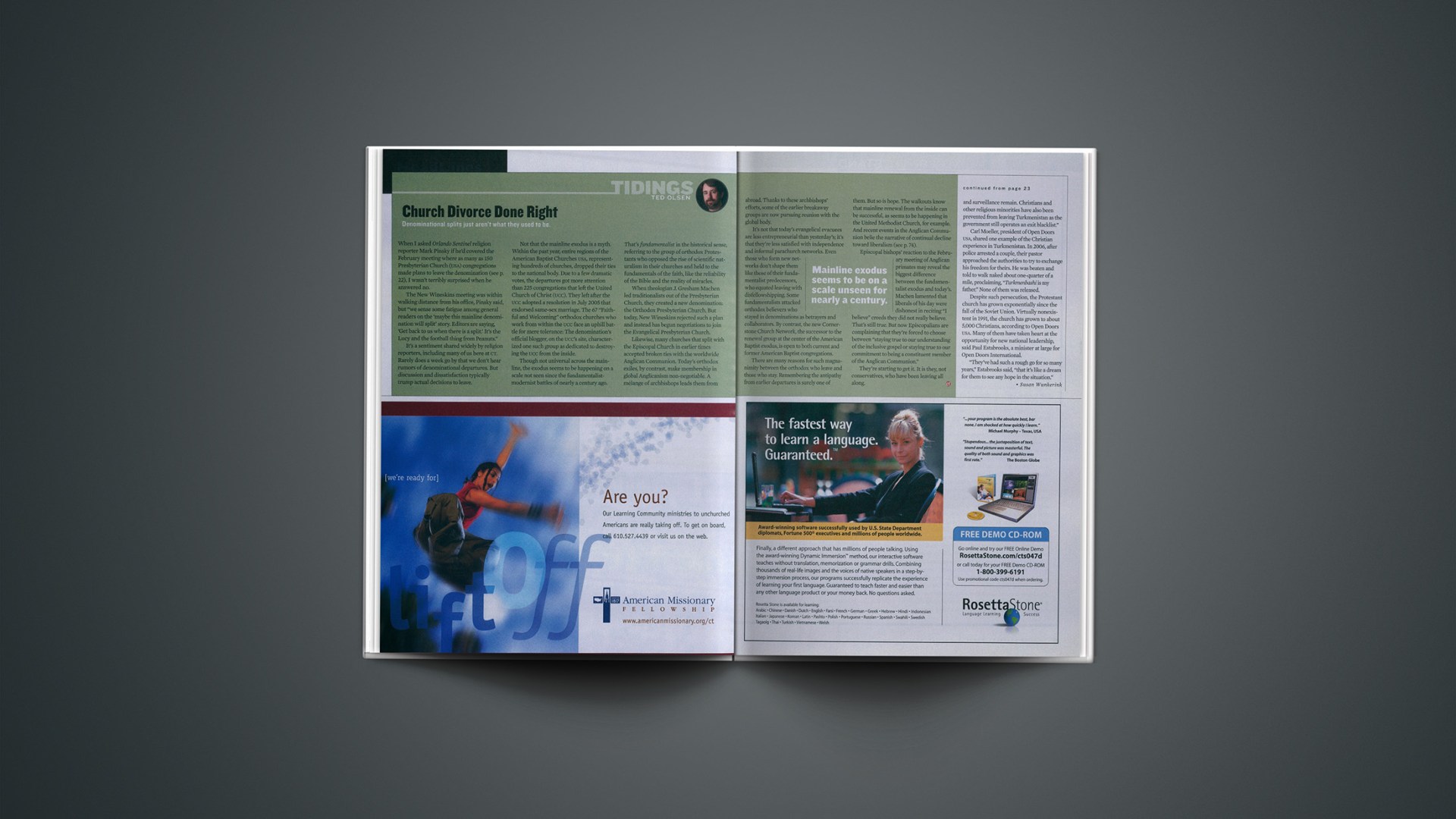When I asked Orlando Sentinel religion reporter Mark Pinsky if he’d covered the February meeting where as many as 150 Presbyterian Church (USA) congregations made plans to leave the denomination, I wasn’t terribly surprised when he answered no.
The New Wineskins meeting was within walking distance from his office, Pinsky said, but “we sense some fatigue among general readers on the ‘maybe this mainline denomination will split’ story. Editors are saying, ‘Get back to us when there is a split.’ It’s the Lucy and the football thing from Peanuts.”
It’s a sentiment shared widely by religion reporters, including many of us here at CT. Rarely does a week go by that we don’t hear rumors of denominational departures. But discussion and dissatisfaction typically trump actual decisions to leave.
Not that the mainline exodus is a myth. Within the past year, entire regions of the American Baptist Churches USA, representing hundreds of churches, dropped their ties to the national body. Due to a few dramatic votes, the departures got more attention than 225 congregations that left the United Church of Christ (UCC). They left after the UCC adopted a resolution in July 2005 that endorsed same-sex marriage. The 67 “Faithful and Welcoming” orthodox churches who work from within the UCC face an uphill battle for mere tolerance: The denomination’s official blogger, on the UCC’s site, characterized one such group as dedicated to destroying the UCC from the inside.
Though not universal across the mainline, the exodus seems to be happening on a scale not seen since the fundamentalist-modernist battles of nearly a century ago. That’s fundamentalist in the historical sense, referring to the group of orthodox Protestants who opposed the rise of scientific naturalism in their churches and held to the fundamentals of the faith, like the reliability of the Bible and the reality of miracles.
When theologian J. Gresham Machen led traditionalists out of the Presbyterian Church, they created a new denomination: the Orthodox Presbyterian Church. But today, New Wineskins rejected such a plan and instead has begun negotiations to join the Evangelical Presbyterian Church.
Likewise, many churches that split with the Episcopal Church in earlier times accepted broken ties with the worldwide Anglican Communion. Today’s orthodox exiles, by contrast, make membership in global Anglicanism non-negotiable. A mélange of archbishops leads them from abroad. Thanks to these archbishops’ efforts, some of the earlier breakaway groups are now pursuing reunion with the global body.
It’s not that today’s evangelical evacuees are less entrepreneurial than yesterday’s; it’s that they’re less satisfied with independence and informal parachurch networks. Even those who form new networks don’t shape them like those of their fundamentalist predecessors, who equated leaving with disfellowshipping. Some fundamentalists attacked orthodox believers who stayed in denominations as betrayers and collaborators. By contrast, the new Cornerstone Church Network, the successor to the renewal group at the center of the American Baptist exodus, is open to both current and former American Baptist congregations.
There are many reasons for such magnanimity between the orthodox who leave and those who stay. Remembering the antipathy from earlier departures is surely one of them. But so is hope. The walkouts know that mainline renewal from the inside can be successful, as seems to be happening in the United Methodist Church, for example. And recent events in the Anglican Communion belie the narrative of continual decline toward liberalism.
Episcopal bishops’ reaction to the February meeting of Anglican primates may reveal the biggest difference between the fundamentalist exodus and today’s. Machen lamented that liberals of his day were dishonest in reciting “I believe” creeds they did not really believe. That’s still true. But now Episcopalians are complaining that they’re forced to choose between “staying true to our understanding of the inclusive gospel or staying true to our commitment to being a constituent member of the Anglican Communion.”
They’re starting to get it. It is they, not conservatives, who have been leaving all along.
Copyright © 2007 Christianity Today. Click for reprint information.
Related Elsewhere:
A version of this column originally ran in the March 2007 print edition of Christianity Today. The column “Tidings” was formerly called “Weblog in Print.” Earlier columns by Ted Olsen include:
Why Isn’t ‘Yes’ Enough? | The fuss over swearing-in ceremonies reveals a deeper problem. (Feb. 23, 2007)
Bottom-Up Discipline | What do you do when your pastor—or your entire denomination—strays? (Jan. 16, 2007)
The Year Conservatives Saved Christmas | We bullied stores out of “Happy Holidays.” Hooray? (Dec. 8, 2006)
What Really Unites Pentecostals? | It’s not speaking in tongues. It may be the prosperity gospel (Dec. 5, 2006)
Does Islam Need a Luther or a Pope? | American pundits debate whether centralized religious authority restrains violence. (Oct. 20, 2006)
Asylum vs. Assistance | Offering sanctuary isn’t about political protest. (Sept. 26, 2006)
We’re Not Spectators | Mideast Christians writing for our website expressed their anguish—and anger. (Aug. 28, 2006)
Latter-day Complaints | Mormons and evangelicals fret over movies, politics, and each other. (Jul. 6, 2006)
Peace, Peace | From the front page to the obits, one day’s news about Christian peacemaking. (Apr. 18, 2006)










